BAE System Bundle
Can BAE Systems Conquer the Future of Defense?
BAE Systems, a titan in the global defense and aerospace arena, recently made a significant move by acquiring Ball Corporation's aerospace division, signaling its commitment to strategic expansion. Formed in 1999, the company has consistently evolved, aiming to be a leading global defense contractor. This BAE System SWOT Analysis can provide deeper insights into its strategic positioning.
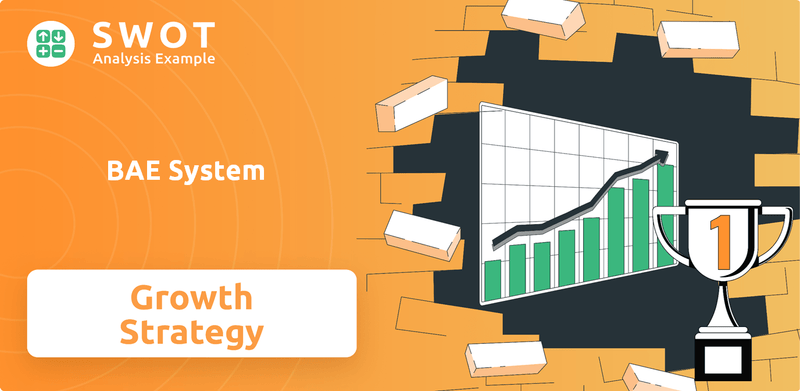
With geopolitical tensions escalating and defense budgets soaring, understanding BAE Systems' growth strategy and future prospects is more critical than ever. This analysis will explore the company's strategic initiatives, including its expansion into the space sector and its focus on technological advancements. We'll also examine the impact of defense industry trends and the aerospace and defense market on BAE Systems' financial performance and long-term growth potential.
How Is BAE System Expanding Its Reach?
The expansion initiatives of BAE Systems are central to its growth strategy and future prospects. The company is actively pursuing a multi-faceted approach, including new market entries, product development, and strategic mergers and acquisitions. This strategy is designed to strengthen its position in the defense industry and capitalize on emerging opportunities. A detailed Target Market of BAE System analysis further underscores the importance of understanding its customer base and market dynamics.
A key element of BAE Systems' expansion involves strategic acquisitions. The acquisition of Ball Corporation's aerospace division for $5.6 billion in February 2024 is a prime example. This move significantly broadened its presence in the space sector. The integration of this division has been progressing well, contributing to accelerating sales in the latter half of 2024.
The company's growth is also fueled by substantial contract wins, which provide strong revenue visibility for the coming years. This includes a $2.5 billion deal for CV90 combat vehicles with Sweden and Denmark, and a £285 million contract with the UK Ministry of Defence for Royal Navy combat systems upgrades. The total order intake for 2024 was approximately £25 billion by November, contributing to a record order backlog of £77.8 billion. This impressive backlog ensures sustained revenue generation over several years, supporting BAE Systems' long-term growth potential.
BAE Systems is focused on strengthening its presence in key defense markets. The US accounts for nearly 50% of its sales, benefiting from substantial military spending. The company also aims to increase its presence in Asia-Pacific and the Middle East, where defense spending is expected to rise. This global expansion strategy is crucial for sustained growth.
BAE Systems is making significant investments in its facilities to enhance capacity and efficiency. These investments include a new explosives filling facility in South Wales, a new shipbuild assembly hall in Glasgow, and a modern shiplift and land-level repair complex in Florida. These investments, totaling over £1.0 billion in capital expenditure in 2024, are vital for supporting future growth.
To support its future growth, BAE Systems plans to recruit over 2,400 new apprentice, undergraduate, and graduate roles in the UK in 2025. This commitment to workforce development underscores its dedication to innovation and maintaining a skilled workforce. This initiative is crucial for driving technological advancements.
In 2024, BAE Systems secured major contracts, including a $2.5 billion deal for CV90 combat vehicles. The company's order backlog reached a record £77.8 billion. The total order intake for 2024 was approximately £25 billion by November. These figures highlight the company's robust financial performance and strong position in the aerospace and defense market.
BAE Systems' strategic initiatives are designed to drive revenue growth and capitalize on defense industry trends. The company's focus on mergers and acquisitions, particularly in the space sector, is a key driver. The company is also investing heavily in research and development to ensure its technological advancements.
- Expansion into the space sector through acquisitions.
- Securing significant government contracts.
- Investing in new facilities and workforce development.
- Focus on long-term growth potential in key markets.
BAE System SWOT Analysis
- Complete SWOT Breakdown
- Fully Customizable
- Editable in Excel & Word
- Professional Formatting
- Investor-Ready Format
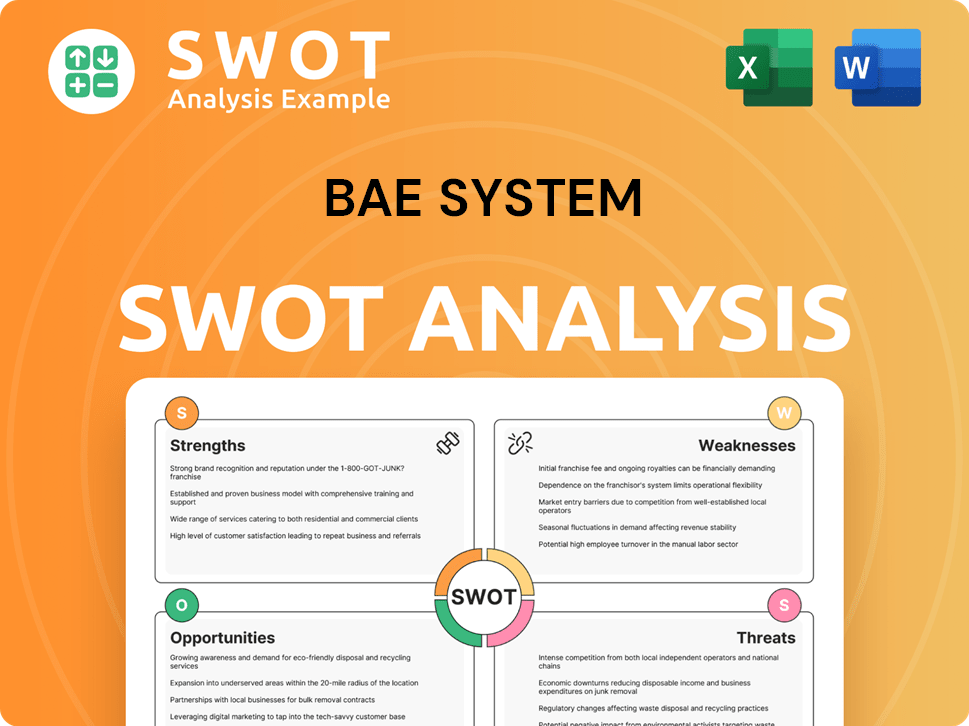
How Does BAE System Invest in Innovation?
BAE Systems actively employs innovation and technology as key drivers for its growth strategy, focusing on substantial investments in research and development (R&D) and strategic collaborations. These efforts are crucial for navigating the evolving landscape of the aerospace and defense market.
The company's commitment to technological advancement is evident in its strategic investments and partnerships. By focusing on cutting-edge technologies, BAE Systems aims to maintain a competitive edge and capitalize on emerging opportunities within the defense industry trends.
BAE Systems' approach to innovation is multifaceted, involving both internal R&D and external collaborations to ensure it remains at the forefront of technological advancements, which is critical for its future prospects.
In 2024, BAE Systems invested a record amount in research and development and capital expenditure. This investment underscores the company's commitment to innovation and its long-term growth potential.
Self-funded R&D is strategically directed towards key technological areas. These areas include electronic warfare, autonomy, and laser-guided weapons, among others. These investments are crucial for BAE Systems' strategic initiatives 2024.
The company is continuously developing advanced capabilities through digital transformation. This includes the recent unveiling of M-Code versions for its GPS receivers, enhancing secure positioning capabilities.
BAE Systems is positioning itself in autonomous ground vehicle innovation through a strategic partnership with Forterra. This collaboration aims to develop autonomous ground vehicles, shaping future battlefields.
BAE Systems is a key participant in major defense projects. This includes the Lockheed Martin F-35 Lightning II and the Eurofighter Typhoon, which contribute to its revenue growth drivers.
The company secured a $251 million contract in February 2025 to support the U.S. Navy's AEGIS Combat System. This demonstrates BAE Systems' commitment to government contracts.
BAE Systems' R&D investments are focused on several key technological areas. These areas include electronic warfare, autonomy, laser-guided weapons, uncrewed air systems, synthetic training, electrification applications, and space solutions. These investments are aimed at increasing future capacity and modernizing their systems. This approach is crucial for BAE Systems' competitive landscape.
- Electronic Warfare: Enhancing capabilities to counter evolving threats.
- Autonomy: Developing autonomous systems for various applications.
- Laser-Guided Weapons: Advancing precision strike capabilities.
- Uncrewed Air Systems: Expanding unmanned aerial vehicle technologies.
- Synthetic Training: Improving training through simulation technologies.
- Electrification Applications: Focusing on electric propulsion systems.
- Space Solutions: Developing technologies for space-based applications.
BAE System PESTLE Analysis
- Covers All 6 PESTLE Categories
- No Research Needed – Save Hours of Work
- Built by Experts, Trusted by Consultants
- Instant Download, Ready to Use
- 100% Editable, Fully Customizable
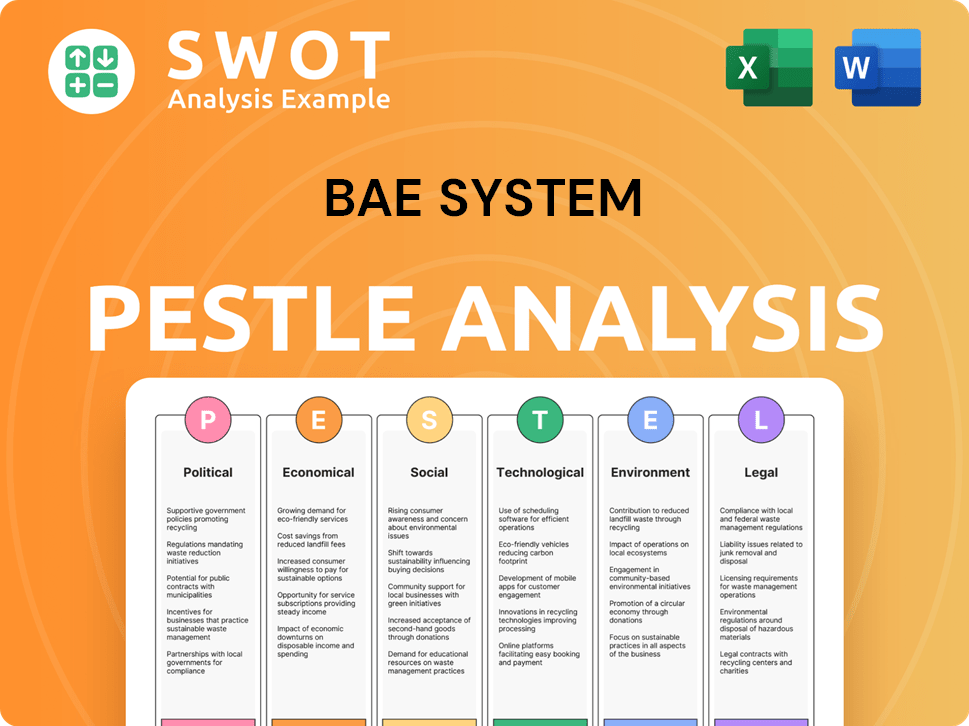
What Is BAE System’s Growth Forecast?
The financial outlook for BAE Systems is robust, underpinned by increasing global defense spending and a substantial order backlog. The company anticipates continued strong financial performance, with a focus on sustained growth. This positive outlook is supported by the company's strategic initiatives and its position within the aerospace and defense market.
BAE Systems' growth strategy is geared toward capitalizing on opportunities within the defense industry. The company's financial performance is expected to benefit from its record order backlog, providing significant revenue visibility. This strong financial position allows for investments in research and development, new product development, and potential mergers and acquisitions.
The company's future prospects are promising, with analysts projecting continued revenue growth and stable profitability. The company's sustainability efforts and technological advancements also contribute to its long-term growth potential. For an in-depth look at the company's marketing strategy, consider reading the Marketing Strategy of BAE System.
For 2025, BAE Systems expects sales to grow between 7% and 9% from its 2024 base of £28.3 billion. Underlying operating profits are projected to increase by 8% to 10% from £3.0 billion in 2024. Underlying earnings per share are also expected to rise by 8% to 10% from 68.5 pence.
The company's record order backlog reached £77.8 billion at the end of 2024, ensuring significant revenue visibility for the long term. S&P Global Ratings forecasts revenue to increase to more than £28 billion in 2025 and approximately £30 billion in 2026. This strong backlog supports BAE Systems' long-term growth potential.
S&P Global Ratings upgraded BAE Systems' long-term issuer credit rating to 'A-' in May 2025, reflecting expectations of continued top-line growth and stable profitability. The company's strong demand outlook and robust free cash flow position it well to manage debt payments, even after the debt-funded acquisition of Ball Aerospace.
BAE Systems commenced a three-year, up to £1.5 billion share buyback program in July 2024, with £392 million completed as of May 6, 2025. The final dividend for 2024 of 20.6 pence per share is expected to be paid on June 2, 2025. These actions reflect the company's commitment to shareholder value.
In 2024, BAE Systems reported a 14% increase in revenue to £28.3 billion and an operating profit increase of 4% to £2.7 billion. The net profit margin in 2024 was 7.4%.
- Revenue: £28.3 billion
- Operating Profit: £2.7 billion
- Net Profit Margin: 7.4%
- Order Backlog: £77.8 billion
BAE System Business Model Canvas
- Complete 9-Block Business Model Canvas
- Effortlessly Communicate Your Business Strategy
- Investor-Ready BMC Format
- 100% Editable and Customizable
- Clear and Structured Layout
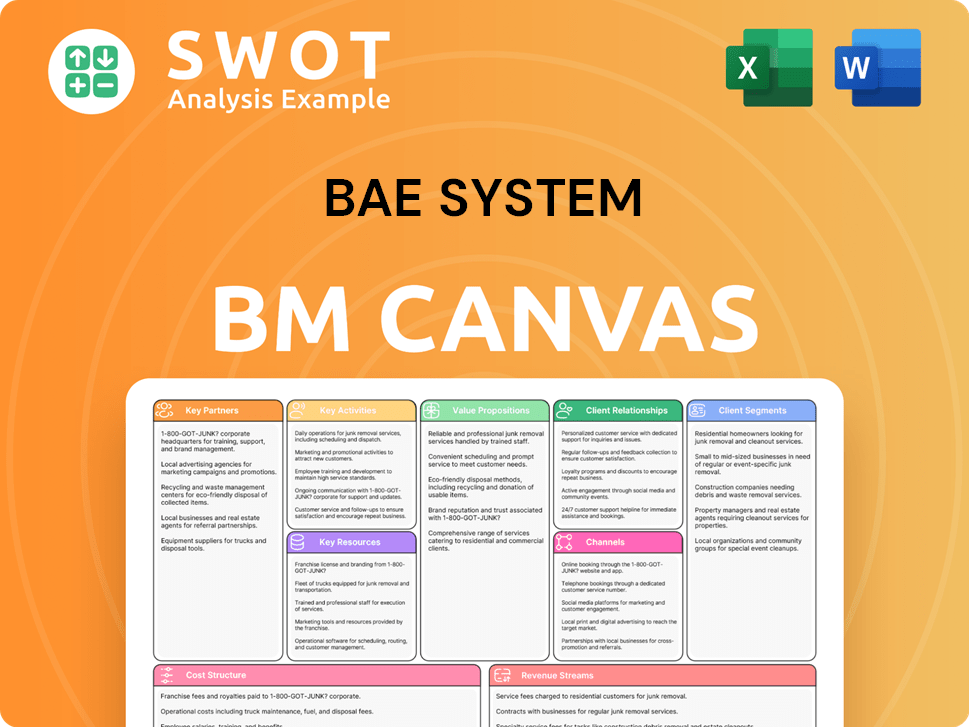
What Risks Could Slow BAE System’s Growth?
The future prospects of BAE Systems are subject to several potential risks and obstacles. The company's reliance on government defense spending, especially in the US, introduces vulnerability to political and budgetary shifts. Operational challenges and technological disruptions further complicate the path to sustained growth for BAE Systems.
A key factor impacting BAE Systems' growth is the potential for defense budget cuts. The aerospace and defense market is highly sensitive to geopolitical events and government policies. Additionally, the long-term nature of defense contracts introduces risks related to cost overruns and production delays.
Technological advancements and stringent regulatory requirements also present challenges. The company needs to continuously invest in research and development to maintain its competitive edge. Furthermore, global operations expose BAE Systems to currency fluctuations and require compliance with complex regulations.
BAE Systems' revenue is heavily reliant on government defense contracts. A significant portion, nearly 50%, of its sales come from the US. Any cuts in the US military budget, as indicated by various sources, could directly impact the company's order flow and financial performance. This dependence makes BAE Systems vulnerable to political shifts and policy changes.
Large, long-term contracts carry inherent operational risks. These include potential cost overruns and delays in production, as highlighted by management. Supply chain vulnerabilities and production delays are also identified as key potential 'trip hazards'. The long-term nature of these contracts means that related risks and costs can change over time, affecting profitability and overall financial health.
The rapid pace of technological change necessitates consistent investment in research and development. BAE Systems must continuously innovate in areas like electronic warfare, autonomy, and space solutions to remain competitive. The need to stay ahead of emerging threats and technological advancements adds constant pressure on the company to maintain its position in the aerospace and defense market.
Strict regulatory and compliance requirements in the defense industry pose legal and reputational risks. Global operations also expose the company to currency fluctuations. BAE Systems must navigate complex regulations and maintain high standards to avoid penalties and protect its reputation. The company's operations are subject to scrutiny and potential legal challenges.
BAE Systems' valuation, with a price-to-earnings (P/E) ratio above 30 as of early June 2025, suggests that a lot of its strength is already priced in. This increases the risk of market punishment for any missteps. Investors may react strongly to any negative news or underperformance, potentially impacting the company's stock forecast and market share analysis.
Geopolitical events and economic conditions can significantly impact the defense industry. Changes in global defense spending, trade policies, and currency exchange rates can affect BAE Systems' financial performance. The company must monitor these factors closely and adjust its strategies accordingly to manage potential risks and maintain its global expansion strategy.
To mitigate these risks, BAE Systems employs a diversified portfolio and robust risk management frameworks. The company continuously invests in its capabilities and capacity. By diversifying its revenue streams and proactively managing risks, BAE Systems aims to navigate the challenges and maintain its long-term growth potential. For more detailed insights into BAE Systems' business model, you can read about the Revenue Streams & Business Model of BAE System.
BAE Systems is actively involved in research and development spending to foster innovation and maintain its competitive edge. These initiatives are crucial for developing new product development and staying ahead of technological advancements. The company's focus on areas like electronic warfare, autonomy, and space solutions is expected to drive future growth.
BAE System Porter's Five Forces Analysis
- Covers All 5 Competitive Forces in Detail
- Structured for Consultants, Students, and Founders
- 100% Editable in Microsoft Word & Excel
- Instant Digital Download – Use Immediately
- Compatible with Mac & PC – Fully Unlocked
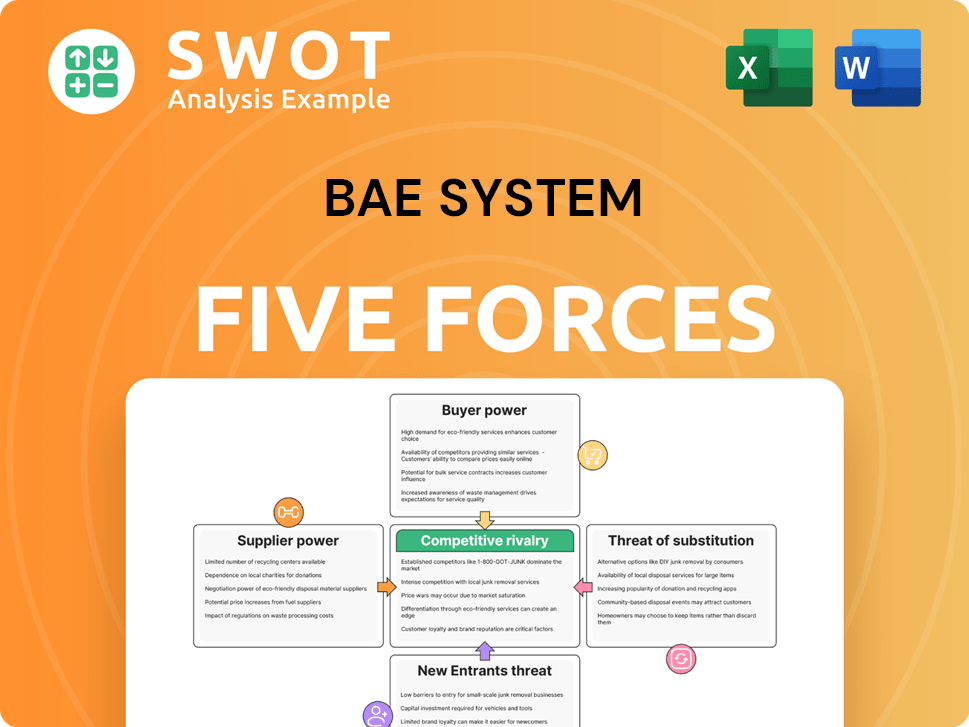
Related Blogs
- What are Mission Vision & Core Values of BAE System Company?
- What is Competitive Landscape of BAE System Company?
- How Does BAE System Company Work?
- What is Sales and Marketing Strategy of BAE System Company?
- What is Brief History of BAE System Company?
- Who Owns BAE System Company?
- What is Customer Demographics and Target Market of BAE System Company?
Disclaimer
All information, articles, and product details provided on this website are for general informational and educational purposes only. We do not claim any ownership over, nor do we intend to infringe upon, any trademarks, copyrights, logos, brand names, or other intellectual property mentioned or depicted on this site. Such intellectual property remains the property of its respective owners, and any references here are made solely for identification or informational purposes, without implying any affiliation, endorsement, or partnership.
We make no representations or warranties, express or implied, regarding the accuracy, completeness, or suitability of any content or products presented. Nothing on this website should be construed as legal, tax, investment, financial, medical, or other professional advice. In addition, no part of this site—including articles or product references—constitutes a solicitation, recommendation, endorsement, advertisement, or offer to buy or sell any securities, franchises, or other financial instruments, particularly in jurisdictions where such activity would be unlawful.
All content is of a general nature and may not address the specific circumstances of any individual or entity. It is not a substitute for professional advice or services. Any actions you take based on the information provided here are strictly at your own risk. You accept full responsibility for any decisions or outcomes arising from your use of this website and agree to release us from any liability in connection with your use of, or reliance upon, the content or products found herein.